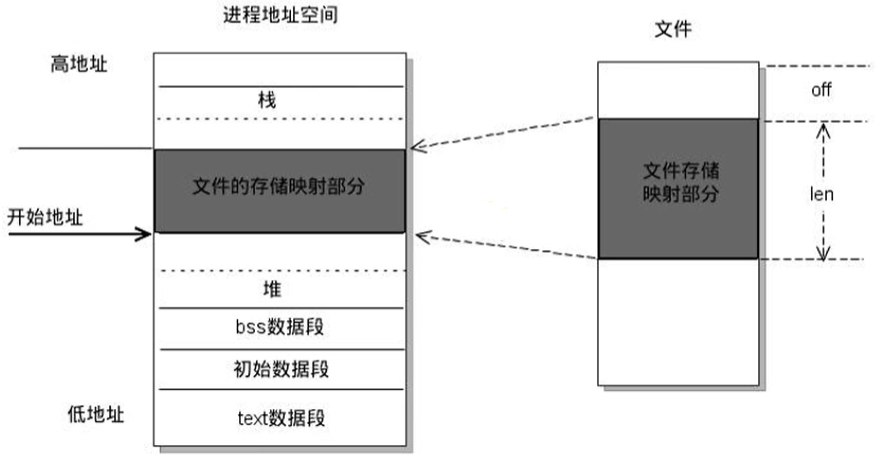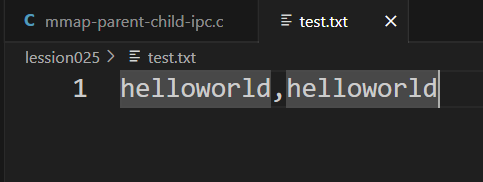橙色
内存映射
- 内存映射(Memory-mapped I/o)是将磁盘文件的数据映射到内存,用户通过修改内存就能修改磁盘文件。

相关函数解析
/*
#include <sys/mman.h>
void *mmap(void *addr, size_t length, int prot, int flags,int fd, off_t offset);
- 功能:将一个文件或者设备的数据映射到内存中
- 参数:
- void *addr: NULL, 由内核指定,不用管
- length : 要映射的数据的长度,这个值不能为0。建议使用文件的长度。
获取文件的长度:stat lseek
- prot : 对申请的内存映射区的操作权限
-PROT_EXEC :可执行的权限
-PROT_READ :读权限
-PROT_WRITE :写权限
-PROT_NONE :没有权限
要操作映射内存,必须要有读的权限。
PROT_READ、PROT_READ|PROT_WRITE
- flags :
- MAP_SHARED : 映射区的数据会自动和磁盘文件进行同步,进程间通信,必须要设置这个选项
- MAP_PRIVATE :不同步,内存映射区的数据改变了,对原来的文件不会修改,会重新创建一个新的文件。(copy on write)
- fd: 需要映射的那个文件的文件描述符
- 通过open得到,open的是一个磁盘文件
- 注意:文件的大小不能为0,open指定的权限不能和prot参数有冲突。
prot: PROT_READ open:只读/读写
prot: PROT_READ | PROT_WRITE open:读写
- offset:偏移量,一般不用。必须指定的是4k的整数倍,0表示不偏移 。
- 返回值:返回创建的内存的首地址
失败返回MAP_FAILED,(void *) -1
int munmap(void *addr, size_t length);
- 功能:释放内存映射
- 参数:
- addr : 要释放的内存的首地址
- length : 要释放的内存的大小,要和mmap函数中的length参数的值一样。
*/
/*
使用内存映射实现进程间通信:
1.有关系的进程(父子进程)
- 还没有子进程的时候
- 通过唯一的父进程,先创建内存映射区
- 有了内存映射区以后,创建子进程
- 父子进程共享创建的内存映射区
2.没有关系的进程间通信
- 准备一个大小不是0的磁盘文件
- 进程1 通过磁盘文件创建内存映射区
- 得到一个操作这块内存的指针
- 进程2 通过磁盘文件创建内存映射区
- 得到一个操作这块内存的指针
- 使用内存映射区通信
注意:内存映射区通信,是非阻塞。
*/
代码示例1(使用内存映射实现没有关系的进程间的通信):
#include <stdio.h>
#include <sys/mman.h>
#include <fcntl.h>
#include <sys/types.h>
#include <unistd.h>
#include <string.h>
#include <stdlib.h>
#include <wait.h>
// 作业:使用内存映射实现没有关系的进程间的通信。
int main() {
// 1.打开一个文件
int fd = open("test.txt", O_RDWR);
int size = lseek(fd, 0, SEEK_END); // 获取文件的大小
// 2.创建内存映射区
void *ptr = mmap(NULL, size, PROT_READ | PROT_WRITE, MAP_SHARED, fd, 0);
if(ptr == MAP_FAILED) {
perror("mmap");
exit(0);
}
// 3.创建子进程
pid_t pid = fork();
if(pid > 0) {
wait(NULL);
// 父进程
char buf[64];
strcpy(buf, (char *)ptr);
printf("read data : %s\n", buf);
}else if(pid == 0){
// 子进程
strcpy((char *)ptr, "nihao a, son!!!");
}
// 关闭内存映射区
munmap(ptr, size);
return 0;
}
与该程序文件在同一个目录下的还有一个txt文件,内容如下:

在执行了该程序文件后,txt文件内容如下:

效果并不是特别好,因为可以看到这是覆盖了之前的一部分内容。所以上面的内容仅作为对内存映射的一个理解。
代码示例2(使用内存映射实现文件间拷贝):

copy.c内容如下:
// 使用内存映射实现文件拷贝的功能
/*
思路:
1.对原始的文件进行内存映射
2.创建一个新文件(拓展该文件)
3.把新文件的数据映射到内存中
4.通过内存拷贝将第一个文件的内存数据拷贝到新的文件内存中
5.释放资源
*/
#include <stdio.h>
#include <sys/mman.h>
#include <sys/types.h>
#include <sys/stat.h>
#include <fcntl.h>
#include <unistd.h>
#include <string.h>
#include <stdlib.h>
int main() {
// 1.对原始的文件进行内存映射
int fd = open("english.txt", O_RDWR);
if(fd == -1) {
perror("open");
exit(0);
}
// 获取原始文件的大小
int len = lseek(fd, 0, SEEK_END);
// 2.创建一个新文件(拓展该文件)
int fd1 = open("cpy.txt", O_RDWR | O_CREAT, 0664);
if(fd1 == -1) {
perror("open");
exit(0);
}
// 对新创建的文件进行拓展
truncate("cpy.txt", len);
write(fd1, " ", 1);//向其中写入一个空格
// 3.分别做内存映射
void * ptr = mmap(NULL, len, PROT_READ | PROT_WRITE, MAP_SHARED, fd, 0);
void * ptr1 = mmap(NULL, len, PROT_READ | PROT_WRITE, MAP_SHARED, fd1, 0);
if(ptr == MAP_FAILED) {
perror("mmap");
exit(0);
}
if(ptr1 == MAP_FAILED) {
perror("mmap");
exit(0);
}
// 内存拷贝
memcpy(ptr1, ptr, len);
// 释放资源
munmap(ptr1, len);
munmap(ptr, len);
close(fd1);
close(fd);
return 0;
}
english内容如下:
第一篇:Youth 青春
Youth
Youth is not a time of life; it is a state of mind; it is not a matter of rosy cheeks, red lips and supple knees; it is a matter of the will, a quality of the imagination, a vigor of the emotions; it is the freshness of the deep springs of life.
Youth means a temperamental predominance of courage over timidity, of the appetite for adventure over the love of ease. This often exists in a man of 60 more than a boy of 20. Nobody grows old merely by a number of years. We grow old by deserting our ideals.
Years may wrinkle the skin, but to give up enthusiasm wrinkles the soul. Worry, fear, self-distrust bows the heart and turns the spirit back to dust.
Whether 60 or 16, there is in every human being’s heart the lure of wonders, the unfailing appetite for what’s next and the joy of the game of living. In the center of your heart and my heart, there is a wireless station; so long as it receives messages of beauty, hope, courage and power from man and from the infinite, so long as you are young.
When your aerials are down, and your spirit is covered with snows of cynicism and the ice of pessimism, then you’ve grown old, even at 20; but as long as your aerials are up, to catch waves of optimism, there’s hope you may die young at 80.
译文:
青春
青春不是年华,而是心境;青春不是桃面、丹唇、柔膝,而是深沉的意志,恢宏的想象,炙热的恋情;青春是生命的深泉在涌流。
青春气贯长虹,勇锐盖过怯弱,进取压倒苟安。如此锐气,二十后生而有之,六旬男子则更多见。年岁有加,并非垂老,理想丢弃,方堕暮年。
岁月悠悠,衰微只及肌肤;热忱抛却,颓废必致灵魂。忧烦,惶恐,丧失自信,定使心灵扭曲,意气如灰。
无论年届花甲,拟或二八芳龄,心中皆有生命之欢乐,奇迹之诱惑,孩童般天真久盛不衰。人人心中皆有一台天线,只要你从天上人间接受美好、希望、欢乐、勇气和力量的信号,你就青春永驻,风华常存。 、
一旦天线下降,锐气便被冰雪覆盖,玩世不恭、自暴自弃油然而生,即使年方二十,实已垂垂老矣;然则只要树起天线,捕捉乐观信号,你就有望在八十高龄告别尘寰时仍觉年轻。
编译运行程序后:

匿名内存映射
/*
匿名映射:不需要文件实体进程一个内存映射
*/
#include <stdio.h>
#include <sys/mman.h>
#include <sys/types.h>
#include <sys/stat.h>
#include <fcntl.h>
#include <unistd.h>
#include <string.h>
#include <stdlib.h>
#include <sys/wait.h>
int main() {
// 1.创建匿名内存映射区
int len = 4096;
void * ptr = mmap(NULL, len, PROT_READ | PROT_WRITE, MAP_SHARED | MAP_ANONYMOUS, -1, 0);
if(ptr == MAP_FAILED) {
perror("mmap");
exit(0);
}
// 父子进程间通信
pid_t pid = fork();
if(pid > 0) {
// 父进程
strcpy((char *) ptr, "hello, world");
wait(NULL);
}else if(pid == 0) {
// 子进程
sleep(1);
printf("%s\n", (char *)ptr);
}
// 释放内存映射区
int ret = munmap(ptr, len);
if(ret == -1) {
perror("munmap");
exit(0);
}
return 0;
}
最后会输出hello,world
























 749
749











 被折叠的 条评论
为什么被折叠?
被折叠的 条评论
为什么被折叠?










